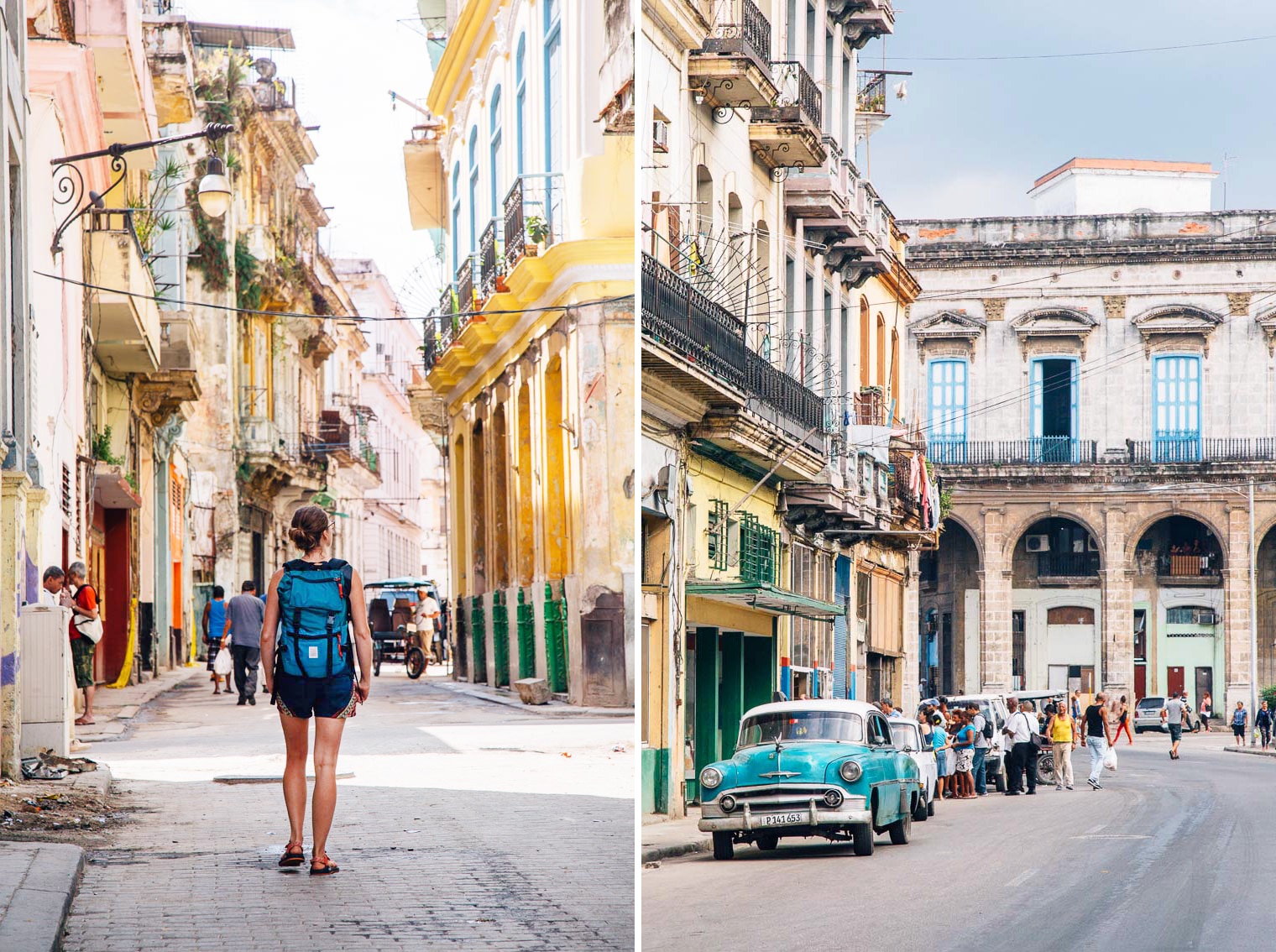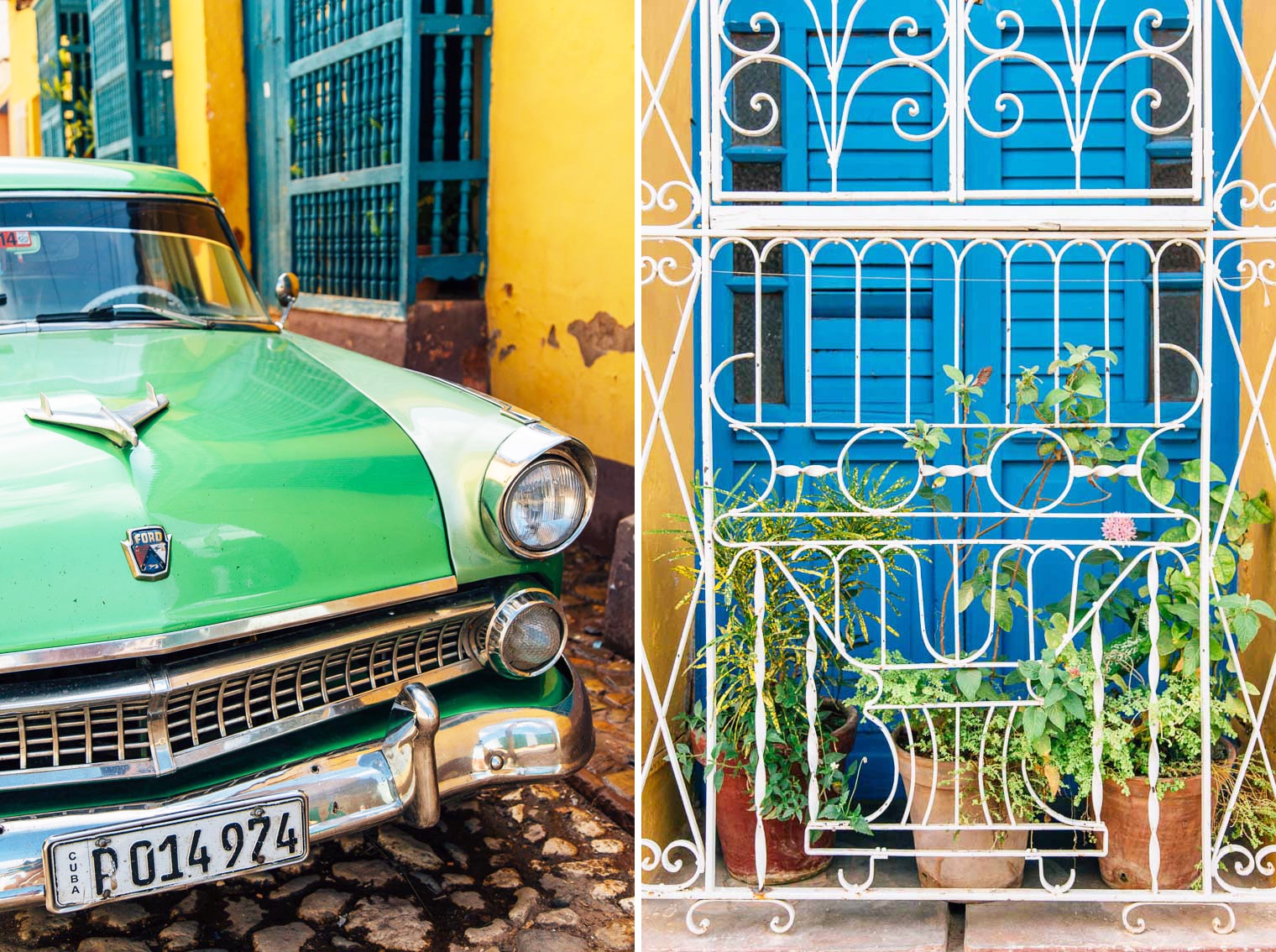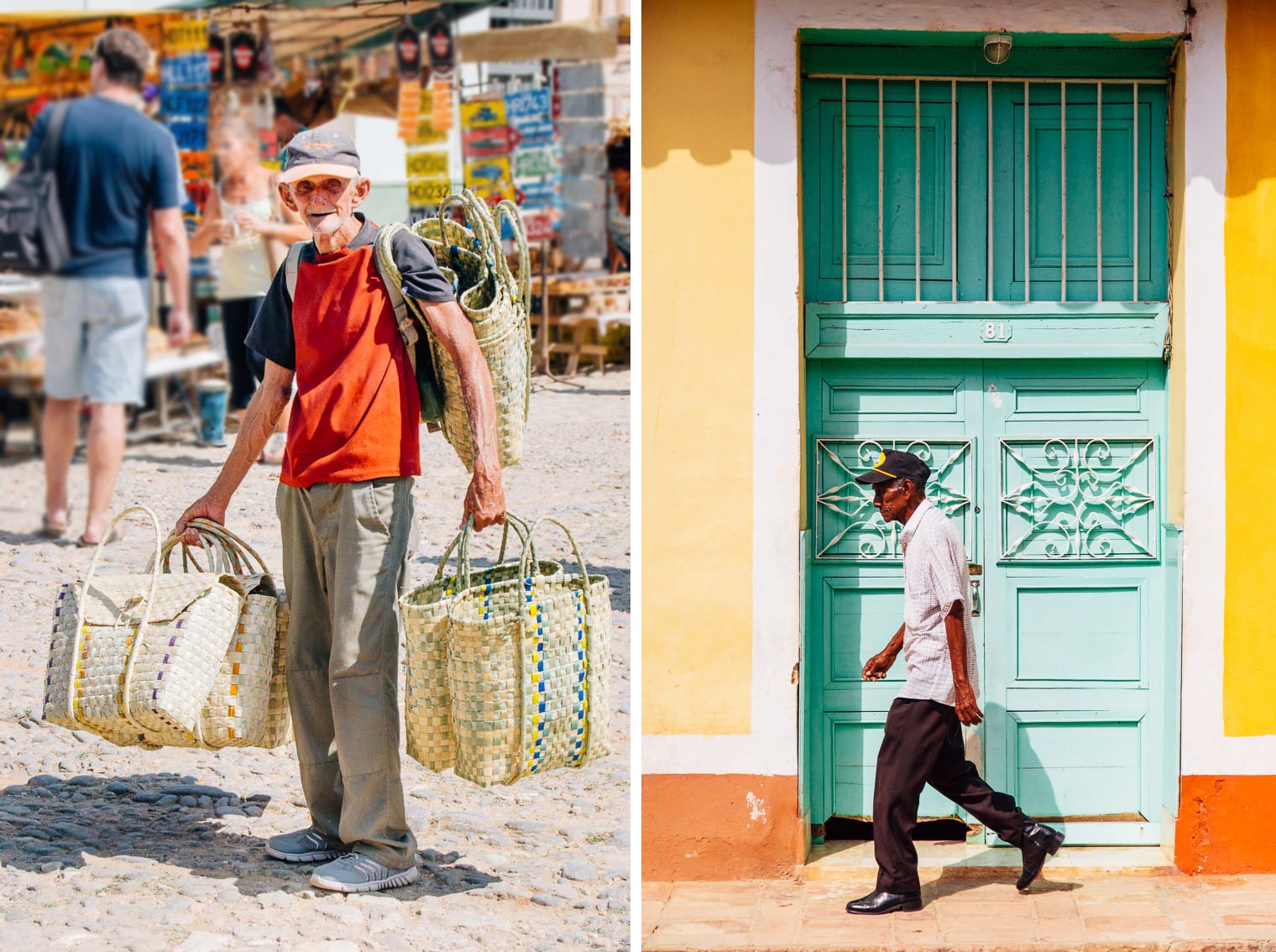¡Bienvenidos a Cuba!
This post may contain affiliate links.
After sitting in a series of climate-controlled airplanes, we emerged on the other end of a long travel day with wrinkled clothes, dry skin, and parched mouths. We had left Los Angeles early in the morning and it was now early the next morning. In a half-conscious state, we staggered up the jet bridge, bumbled through customs, and collected our luggage. We knew we were someplace different, but we couldn’t be certain just how different. However, our confusion melted away the moment the sliding glass doors parted and we stepped outside.
Immediately, the thick warm air filled our lungs, the humidity enveloped us, and our dried up senses were once again revived. As we stood out on the curb, taking in our surroundings, we were hit with a new wave of energy. Just then a pristine 1950’s Ford Fairlane cruised by us in slow motion. For a half second, it felt like we had stepped back in time. And that’s when it hit us: This is it. We are in Cuba.
Back in February, we entered a contest hosted by video sharing app Facet to win a trip to Cuba. Shortly after the contest ended we received an email containing: “Guess what – YOU WON A TRIP TO CUBA!!!!!!!!!!!” Cut to: epic high five. However, the contest was only for one ticket. After briefly considering holding an Instagram vote to see which one of us should go, we opted to pony up and buy a second ticket as neither of us could imagine going without the other.
The trip was organized by boutique tour company Coast To Costa, which is run by the tireless and charismatic Andrew Tyree. We have followed him on Instagram for awhile, so we were excited to get to meet him in person. He specializes in leading hyper-localized, culturally immersive trips to Spanish-speaking countries like Spain, Mexico, and most recently Cuba. However, this was going to be his second trip to Cuba, which he readily admitted was still a work in progress. “This is not a vacation, it’s a journey,” he said. And like a true professional, he under-promised and over delivered.
Back on the airport curb in Havana, we were joined by the rest of our travel group: an eclectic mix of young professionals from Los Angeles and San Francisco. A married couple, two friends, two single riders, and the two of us made eight, with Andrew bringing it to nine. As soon as we all had collected all of our luggage, our man in Havana appeared from the crowd.
With a hoarse yet cheerful voice and disarming smile, we met Jorge. He wrapped his arms around Andrew in a giant bear hug and greeted all of us with an excited zeal not commonly found at 1:30 in the morning. He was initially introduced to us as our driver, but he soon took on the role of local guide, money exchanger, restaurant critic, and all around problem solver. Beyond his professional capacities, we also got to know him as a thoughtful friend and caring father. That night, he was joined by his son Julio, who, while more soft-spoken than his father, turned out to be no less considerate.
After greetings were exchanged, we all piled into Jorge’s shuttle van and made our way into Havana. It was late, but somehow we managed to check into the house we were staying at, unpack, get back into the van, eat dinner at a 24 hours hotel restaurant, and return back around 3am. It was sweltering that night, but we had no difficulty sleeping.
The next morning began when Jorge arrived at the house to exchange our American dollars. Cuba has two official forms of currency the CUC (convertible peso) and CUP (non-convertible peso). The CUC is pegged to the US dollar and is the only form of currency tourists are allowed to use within the country. The CUP is a highly devalued local currency that is used exclusively by Cubans. The use of these two currencies effectively creates two separate economies, one tourist-based, and one state-based. It was a concept we struggled to understand the entire time.
That day we took a walking tour of Old Havana, the cultural heart of the city. Now, in the daylight, we could get a better sense of our surroundings. At first glance, Havana looked exactly like what we were expecting: old colonial architecture, cobblestone streets, and lines of vintage cars. However, a few things stood out, like the state propaganda billboards and the monuments dedicated to Che, Ho Chi Min, and Lenin. These sights felt like ironic novelties at first, perfectly tailored for a touristy photo op. But their presence offered a glimpse into the country’s alternate interpretation of world history and served as a reminder that Cuba, despite the recent normalizing of relations, is still very much a communist run state.
The more we explored the city, the more details of everyday life came to light. While it was easy to swoon over the city’s rustic charm, we began to realize that much of its allure comes from the fact that it is effectively a living ruin. However, the crumbling concrete, cracked tiles, and shabby chic balconies are not the result of an aesthetic choice, but rather years of limited means. Even the old American automobiles, most of which are over a half-century old, have been frankensteined together and kept running not for posterity sake, but out of pure necessity. When viewed in pictures, it’s easy to disassociate from these realities, but when experienced in person it becomes painfully clear. Visiting Cuba might feel like taking a nostalgic glimpse into the past to us, but to the Cuban people, it is very much their present.
That evening, while waiting in line at a restaurant, we met an interesting character named Carlos. Carlos had constructed a radio – which we found out is illegal in Cuba – and had taught himself English by listening to Florida AM talk stations. While he was eager to practice speaking with us, he was even more interested to find out our political affiliation. Years of listening to Sean Hannity and Rush Limbaugh had left a profound effect on him, and we suddenly found ourselves being pitched Donald Trump in the streets of Havana. Far stranger things have happened for sure, but right now we can’t think of any. We offered him a beer, he offered us a cigar, and after a long and fascinating conversation, we parted ways.
After two days in Havana, our group loaded up for a trip to Trinidad – a coastal colonial town on the Caribbean side of the island. Along the way, we fell into conversation with Jorge, who was not only excited to show us his country but happy to answer our countless questions about life in Cuba. With Andrew as our interpreter, we peppered him with questions but quickly realized there are no simple answers in Cuba. We asked about housing, property ownership, salaries, and car insurance, but Jorge found it difficult to give definitive answers. From what we could gather, workarounds had become so common that it was hard to understand exactly what the rules were. The concept of “rent” was particularly hard for us to pin down. The idea of renting a house out to tourists was something Jorge was familiar with, but the idea of Cubans living in a rented apartment seemed like an entirely foreign idea to him. We found that many things were lost in a translation which had nothing to do with language.
We arrived in Trinidad late at night and checked into our house. Much like the house we stayed at in Havana, this was a “casa particular.” The literal translation is “private house”, but the term has come to mean “private accommodation” after the government started allowing Cubans to rent out rooms in their houses to tourists in 1997. They function like a cross between a hostel and a bed & breakfast and offer a unique glimpse into the daily life of everyday Cubans.
The next morning we set out to explore the city by foot. The group was free to split up, but we decided to stick with close to Andrew as he seemed to have a knack of striking up conversations with locals. This proved to be an excellent strategy, as a chance encounter he had with a woman selling bananas on the street, lead us into a tucked away pottery shop, where the long-time owner introduced to a century old cocktail called a Canchanchara and poured us all a round. Following Andrew was like following a human pinball. We never knew exactly where we would end up or how we would get there, but we knew it was going to be an interesting ride.
Towards the of the evening, the group reunited on the stone steps of the main plaza where a healthy crowd of tourists and locals had gathered to take in the evening. We bought a round of Cuba Libres from a street side vendor, passed around the cigar that Carlos gave us back in Havana, and caught each other up on the sights we had seen that day. Behind us, a live band struck up a familiar tune from Buena Vista Social Club and the scene was complete. This was the overly romanticized “Cuba moment” we had all imagined before the trip. Completely unplanned, but entirely welcomed.
After another day on the Caribbean coast, we loaded up in the van and crisscrossed back through Havana to the tobacco growing region near Viñales. Surrounded by low mountains, the lush landscape is dotted with distinctive rock outcrops known as mogotes. Here we toured a tobacco plantation, rode horses through sugar cane fields, and explored one of the many limestone caverns. However, the most memorable experiences here, perhaps of the entire trip, came from our visit to El Paraiso organic farm.
Perched on a hilltop and surrounded by beautifully terraced fields, this family-run organic farm felt like the epitome of bucolic country life. The people, animals, and crops all seemed to work together in perfect harmony. Even the cats and dogs got along and played with each other on the front lawn. However, this agricultural paradise did not exist until recently and was born out of a time of desperate need.
For many years, Cuba heavily relied on the Soviet Union for food. Despite having perfectly suitable soil to grow crops, the state-run agriculture system focused nearly all of its energy on the production of sugarcane. This was sold to the Soviets at a premium in exchange for traditional food staples. However, with the dissolution of the Soviet Union in 1991, Cuba found itself in the middle of a food crisis. There was mass famine throughout the country as the government struggled to feed its people. During this time, the government loosened the rules around small, private land farming and for the first time allowed farmers to sell surplus food directly to the population. Up until then, the only entity allowed to distribute food was the state.
Shortly after the rules were changed, a young couple, Wilfredo and Rachel, began cultivating this plot of land. They didn’t have any experience farming but were compelled to learn by the need to survive. Heavy rains would wash away the soil, so they learned how to build terraces. Fertilizer was prohibitively expensive, so they began experimenting with composting. Chemical pesticides were impossible to obtain, so they learned how to grow their crops organically. Nearly everything had to be learned first hand, but after a few years, the farm started producing.
After cultivating enough food for themselves and their extended families, they opened an onsite restaurant to share meals with guests. The surplus food they generate is donated back to the community and distributed to local orphanages, convalescent homes, and hospitals. The farm also serves as a school to educate their fellow countrymen about organic farming practices. With so many good things going on, it came as no surprise that Finca Parasio was universally loved – by tourists, the local community, and even the government.
Sitting out on the front porch, we enjoyed a spectacular lunch made entirely from the bounty produced by the farm. From fried yucca root to vegetable soup to stewed goat, we had the opportunity to gather plenty of inspiration for future recipes! After the meal, we sat admiring the fields, while cats nimbly darted between our seats picking up the scraps. Between the pastoral setting and the incredible freshness of the food, we couldn’t imagine a more captivating culinary experience.
We spent one more night in Viñales before returning to Havana for our last day in Cuba. But before we had to leave for the airport, Jorge invited the entire group to his home for a final farewell lunch. We had spent nearly a week getting to know him out on the road, so we felt honored to be welcomed into his house. It was clear he had a genuine warmth and affection for us that extended far beyond the usual professional pleasantries. He told us how he had built the house together with his father, showed us the renovations he was doing to the second story, and shared with us his plans to turn his home into a casa particular. Even though he was located just outside of central Havana, he hoped that tourists would want to come and experience an authentic Cuban neighborhood. And from the heart-melting hospitality we received, we knew that Jorge would have great success in this new venture.
Looking back, there was so much about our trip to Cuba that was extraordinary – but what sticks with us most vividly are the personal interactions we had. Speaking with people in the streets and in the fields, hearing about their life experiences, and listening to their hopes and dreams. There is no better portal into another culture than through casual conversations.
While it is easy to romanticize about the colonial architecture, cobblestone streets, and vintage cars, the people are by far Cuba’s greatest attraction. And for the opportunity to connect with them, during this very special period of time, we are completely grateful.
This story was produced in partnership with Coast to Costa and Facet.
























What an amazing post… through your words I can really imagine everything you experienced! I really love that you think the people were the “greatest attraction” there. I think that it shows what you really value when visiting a place. I hope to be able to see this country with my own eyes one day soon!
Thank you for the kind words, Jessica. I’m glad you’re able to live vicariously a little until you’re able to go experience it for yourself 😉
Wow, its like a serious time hop there! Crazy! Its always so eye opening to get outside your own culture and learn how others live their daily life! I love to “tour like a local” when I travel so I can really take in their culture and not just hit up the very Americanized/tourist spots. Those gardens look spectacular – I had no idea they depended on the Soviet Union for so long!
Hi Megan and Michael,
Great to read about your trip and view the beautiful photographs!
Such a joy for me to view your travels and rad your words!
Aunt Robin!
Thank you, Aunt Robin! We’re so happy to be able to share our travels with everyone back home 🙂
Lots of love, Megan